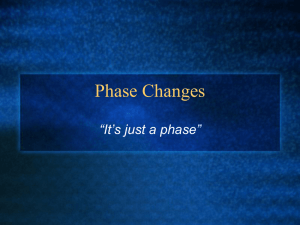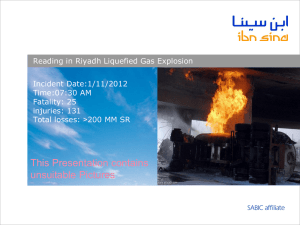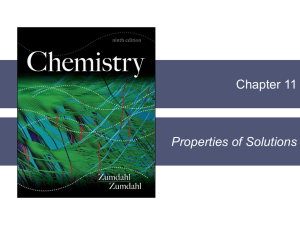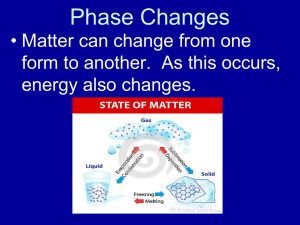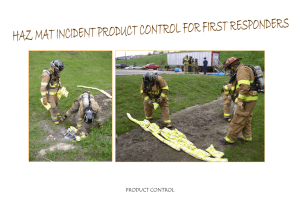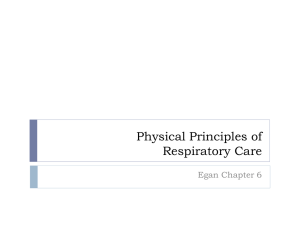Raoult`s law
advertisement
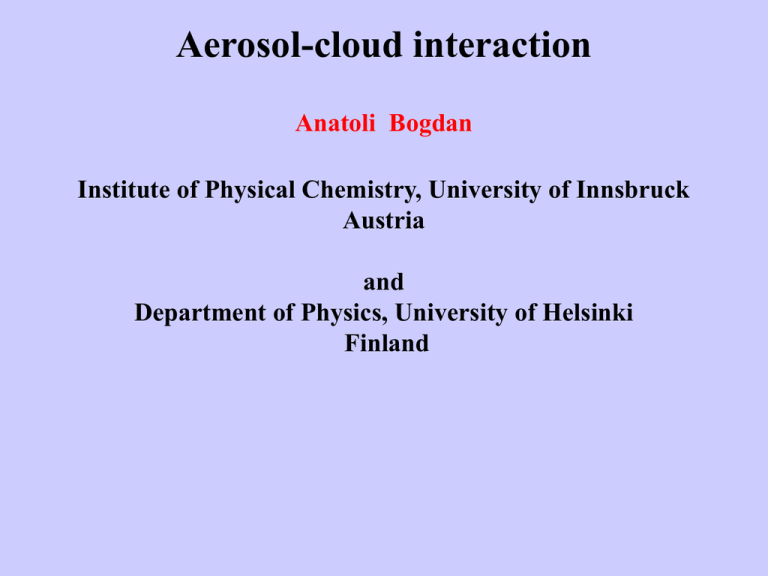
Aerosol-cloud interaction
Anatoli Bogdan
Institute of Physical Chemistry, University of Innsbruck
Austria
and
Department of Physics, University of Helsinki
Finland
Contents
-
role of aerosol in cloud formation
ideal gas
vapor pressure and partial vapor pressure
Kelvin equation
hygroscopic aerosol particles
Raoult’s law
Kohler curves
Cloud condensation nuclei or CCNs or cloud seeds are
small particles (typically 0.2 µm, or 1/100 th the size of
a cloud droplet) about which cloud droplets coalesce. Water
requires a non-gaseous surface to make the transition from
a vapor to a liquid. In the atmosphere, this surface presents
itself as tiny solid or liquid particles called CCNs. When no
CCNs are present, water vapor can be supercooled below
0°C before droplets spontaneously form.
At T > 0 ºC, the air would have to be supersaturated to
~400% before the droplets could form. The concept of
cloud condensation nuclei has led to the idea of cloud
seeding, that tries to encourage rainfall by seeding the
air with condensation nuclei. It has further been
suggested that creating such nuclei could be used for
marine cloud brightening, a geo-engineering technique.
Aerosol pollution over
Northern India and
Bangladesh - NASA
http://en.wikipedia.org/wiki/Cloud_condensation_nuclei
http://earthobservatory.nasa.gov/Features/Aerosols/
Warm Clouds
Warm clouds consist entirely of droplets which have been
formed by condensation onto aerosol particles. Aerosol
particles respond to changes in humidity in different ways
depending on their chemical composition and solubility.
Particles which are soluble or hydrophilic take on water
as humidity increases and increase in size.
Above a certain relative humidity soluble particles will
deliquesce – the solid particle dissolves in the water it
has taken on and becomes a tiny liquid drop, but not
yet a cloud drop. For many soluble salts deliquescence
happens at relative humidity around 60 – 80%.
These droplets exist in equilibrium with water vapor
in the surrounding air.
The growth of such particles with increase in relative
humidity is expressed by the Köhler equation and is a
function of the size and chemical composition of the
particle.
Prior to the consideration of the Kohler aquation,
we will firstly consider several important notions
needed for the understanding of the matter.
General about gases and vapors
Perfect gas
Atmosphere is a mixture of gases. Prier to the study of the real atmosphere
(a mixture of real gases) we firstly will consider a notion of perfect (ideal)
gas. Gas under very small pressure (≤ 1 atm) is a very good approximation of
perfect gas.
In perfect gas:
i) the distance between molecules is much larger than the length of free
path of molecules and
ii) the interaction between molecules is restricted only to their collisions
which are considered to be similar to that of the hard balls.
Thus in the perfect gas, the molecules possess only kinetic energy
whereas potential energy of interaction between the molecules is absent. As
a result internal energy E of perfect gas is independent on pressure and
volume, E ≠ E (p, V). Internal energy is determined only by the kinetic
motion of molecules and can be easily changed by the addition (or
withdrawing) of heat i.e., by changing its temperature. Thus E =E (T).
The atmosphere is a mixture of gases including water vapor
Vapor pressure of water
Above the surface of liquid water there always exists some amount
of vapor and consequently there is a vapor pressure. When a
container containing water is open then the number of the
escaping molecules is larger than the number of molecules coming
back from the vaporphase (Fig. 1). In this case water vapor
pressure is small and far from saturation.
When the container is closed then the water vapor
pressure above the surface increases (concentration of
molecules increases) and therefore the number of
molecules coming back increases too (Fig.2).
After a while, the number of molecules escaping the
liquid and those coming back becomes equal. Such
situation is called by dynamic equilibrium between the
escaping and returning molecules (Fig. 3). In this case,
the water vapor pressure over the liquid water is called
saturated water pressure.
Saturated water vapor pressure is a function of
temperature only and independent on the presence of
other gases.
The temperature dependence is exponential. In the case
of water vapor, the semi empirical dependence reads as
p w ,s e
A
B
C ln T DT
T
where temperature is in Kelvin and A = 77.34, B = -7235,
C = - 8.2, D = 0.005711.
1.3.2 Air humidity
Amount of water vapor in the air can be expressed by several different ways:
Specific humidity: Mass of water vapor per unit mass of humid air:
m H 2O
m air
Absolute humidity: Mass of water vapor per unit volume of humid air (kg/m3).
Relative humidity (RH): Ratio of water vapor pressure pw to the saturated water vapor
pressure at that temperature multiplied by 100%,
RH
=
pw
p
pure
s ,w
(T )
100 % .
(1.53)
Saturation ratio, S: Ratio
S
=
pw
p
pure
s ,w
(T )
.
(1.54)
From the last two definitions we see that RH = S·100% i.e., their physical meanings are
almost the same.
Supersaturation: S - 1 > 0.
For the perfect gas a following (experimental) equation of state p = f (T, V, n) is true
pV= nNAkbT,
(1.1)
where p is pressure, V volume, n number of moles, NA Avogadro number, kb
Boltzmann constant, and T temperature in Kelvin. Since kb NA = R (gas constant), for
the amount of gas of one mole (n = 1) the equation of state (1.1) can be written as
pV = RT.
(1.2)
Using simple kinetic theory of gases and Newton’s laws of motion, one can show
(see, for example, Understanding Physics (1998), p. 249, or Hinds (1982), pp. 15-16)
that
pV = RT = KE =
m mol N
3
2
,
(1.3)
where KE is kinetic energy of the molecules composing the perfect gas, mmol mass of
molecule, N number of molecules, and 2 average of square of molecular velocities
(see below). The expression (1.3) means that the kinetic energy KE, which is also the
internal energy of the perfect gas E, is independent on pressure, volume or molecular
weight and depends only on temperature, i.e. KE = E = E (T),
Equations derived for the perfect gas work also in the case of mixture of gases,
provided that the individual gases (components of the gaseous mixture) and the
mixture itself behave perfectly. Mathematically this means that are valid both: the
equations of state for each component of the gaseous mixture i,
piV = niRT
(1.7)
and the equation of state for the mixture itself
pV = nRT.
(1.8)
Dalton’s law for a mixture of perfect gases: The pressure p exerted by a mixture of
the perfect gases is the sum of the partial pressures pi of the gases. Mathematically it
reads
p = ∑ pi.
(1.9)
Physical meaning of partial pressure: According to the Dalton’s law for the
perfect gases, the pressure p exerted by a gaseous mixture is the sum of the partial
pressures pi of the gases. In the case of the perfect gases, the partial pressure pi is
simply the pressure which the gas would exert if it occupied the container alone at the
same temperature. But in the case of the real gases at moderate pressures, the
interaction between molecules of different gases makes the total pressure being
slightly different (smaller) from the simple sum of the pressures of the gas
components if they were alone. Therefore for the real gas, the partial pressure pi of the
gas component i in the gaseous mixture is defined as
pi = Xi p,
(1.15)
where p is the total pressure of the mixture.(Compare (1.15) with (1.10)). It follows
from Eqs. (1.9) and (1.15) that
p = (X1 + X2 + X3 + · · ·) p = p1 + p2 + p3 + · · · = ∑ pi,
(1.16)
i.e, similar for the mixture of the perfect gases, the sum of the partial pressures of real
gases is also equal to the total pressure of the mixture. (But total pressure of the
mixture of the perfect gases is not equal to that of the real gases!)
Kelvin equation:
ps(r)/ ps(∞) = exp ({2 σw}/{ρwRvTr}) = exp (a/r)
r = droplet radius
ps(r) = the actual vapour pressure of droplet of radius r
ps(∞)= the saturation vapour pressure over bulk water
σw = surface tension
ρw= water density
Rv - the universal gas constant, T - temperature
Example:
Saturation ratio
1
1.1
2
Critical radius
0.12 μm
0.0126 μm
1.73 nm
What is going on with soluble aerosol particles,
for example, such which are composed of NaCl,
sea salt, ammonium sulfate etc.
Hygroscopy is the ability of a substance to attract water
molecules from the atmosphere through either
absorption or adsorption.
Hygroscopic substances include sugar, honey, glycerol,
ethanol, methanol, sulfuric acid, many salts, and many
other substances.
Deliquescent materials (mostly salts) have a strong
affinity for water. Such materials absorb a large amount
of moisture (water vapor) from the atmosphere until it
dissolves in the absorbed water and forms
an aqueous solution.
Deliquescence occurs when the vapour pressure of
aqueous solution is smaller than the partial pressure of
water in the atmosphere.
All soluble salts will deliquesce if the air is sufficiently
humid.
1.4.1 Raoult’s law
a) Ideal solution: The expression (1.58) shows that the chemical potential of the
liquid A in the solution increases with increasing the partial vapor pressure pA and
becomes equal to the chemical potential of pure liquid when pA = p*A. The French
chemist F. Raoult experimentally found that the ratio of the partial vapor pressure of
the component A to its vapor pressure as a pure liquid is approximately equal to the
mole fraction XA (see 1.13) in the solution i.e.,
pA
p
A
X
A
or
pA = XA p*A.
(1.60)
The Eq. (1.60) is known as the Raoult’s law. The Raoult’s law is valid also for the
component B. Linear dependence of the partial vapor pressures pA and pB are shown
by the dashed lines in Fig. 6.
Fig. 6. Equilibrium partial pressures of the components of ideal and non-ideal binary
solution as a function of the mole fraction XA. For the real solution, relationships
between the pA, pB, and the mole fractions XA, XB are not linear as it is in the case of
ideal solution where the linear relationships are shown by the straight dashed lines LR
and KQ. When XA → 1, then we have a dilute solution of B in A. In this region
the Raoult’s law pA = XA p*A is applied for the component A. For the component B
the Henry’s law pB = KB XB is applied. In the region where XA → 0, we
have the Raoult’s law pB = XB p*B for B component and the Henry’s law
pA = KA XA for A component. The straight lines LM and KN depict the Henry’s
The solutions, which obey the Raoult’s law throughout the whole
composition range from pure A to pure B, are called ideal solutions.
The solutions, which components are structurally similar,
obey the Raoult’s law very well. In Fig. 6, the equilibrium
partial pressures of the components A and B in the ideal
solution are shown by dashed lines of LR and KQ.
Solution is only ideal if is satisfied for each
component.
Dissimilar liquids (large difference in the liquid structures)
significantly depart from the Raoult’s law. Nevertheless,
even for these mixtures, the Raoult’s law is obeyed closely
for the component in excess as it approaches purity i.e.,
when XA → 1 or XA → 0 (Fig. 6).
Raoult’s law: Mathematically, for a plane water surface
the reduction in vapour pressure due to the presence of a
non-volatile solute is expressed:
p* (∞)/ps(∞) = 1 – (3νmsMw)/(4 πMsρwr3) = 1 - b/r3
where
p* (∞) - the saturation vapour pressure of pure water
ps* (∞) - the saturation vapour pressure of bulk solution
Ms- molecular weight of the solute
Ms- mass of the solute
Ν- degree of dissociation
Combining the Kelvin equation and the expression from the
Raoult’s law, we can obtain so called Kohler equation.
Köhler Curve = Kelvin equation + Raoult’s law
p*(r)/ps(∞) = (1 - b/r3)·exp(a/r) ≈ 1 + a/r - b/r3
where
a ~ 3.3 10-7/T [m]
b ~ 4.3 10-6i Ms/ms [m3/mol]
Ms= molecular mass of salt [kg/mol]
ms= mass of salt [kg]
The critical radius rc and critical supersaturation Sc are
calculated as
rc= (3b/a)1/2 and Sc= (4 a3/[27 b])1/2
Kohler curves show how the critical diameter and critical
supersaturation are dependent upon the amount of solute.
http://en.wikipedia.org/wiki/File:Kohler_curves.png
As humidity increases, aerosol continues to swell, even after
vapor saturation is reached. Once a critical supersaturation
is reached, corresponding to the peak of the Köhler curve for
that particle, a particle becomes activated as a cloud droplet.
Activated particles are no longer in stable equilibrium with
the vapor phase, but are able to continue to grow by vapor
deposition provided that conditions remain supersaturated.
Droplet size is determined by the number of particles
activated and the amount of water vapor available for
condensation which is generally determined by the vertical
height of an adiabatic ascent. If droplets are able to grow to
a sufficient size and the cloud exists for a sufficient length of
time droplets will coalesce as they collide with each other
through random motion, gravitational settling, or motion
within the dynamics of the cloud system.

